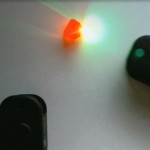 Gummy bears are a great way to bust one of the common misconceptions about light reflection. The misconception is this: most students think that color is a property of matter, for example if I place shiny red apple of a sheet of paper in the sun, you’ll see a red glow on the paper around the apple.
Gummy bears are a great way to bust one of the common misconceptions about light reflection. The misconception is this: most students think that color is a property of matter, for example if I place shiny red apple of a sheet of paper in the sun, you’ll see a red glow on the paper around the apple.
Where did the red light come from? Did the apple add color to the otherwise clear sunlight? No. That’s the problem. Well, actually that’s the idea that leads to big problems later on down the road. So let’s get this idea straightened out.
Please login or register to read the rest of this content.

Interesting results! What colors did you see?
My theory would be that the more hardened part of the jelly beans have hardened sugar crystals, which are refracting and reflecting the light. The gummy center of the jelly beans act as a filter (like the gummy bears), so some light is passing through and some is being absorbed. So you are most likely seeing a combination of light effects.
so we tried this with gummy bears and jellybeans. and the yellow and orange jellybeans had an unexpected special effect!! they looked sort of like the tv fuzz that you get when there is no tv service. just wondering if there is an explanation for that that might apply to light? or chemistry? (like from a certain ingredient or something?)